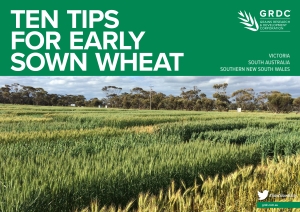Ten top tips to get the most from early sown wheat
Ten top tips to get the most from early sown wheat
Author: GRDC Adelaide office | Date: 26 Mar 2020

It’s not too late for grain growers to extract the most from early sown wheat crops in 2020.
To help growers in Victoria, South Australia and southern New South Wales optimise yields and profitability from early sown wheat, the Grains Research and Development Corporation (GRDC) has published a Ten Tips For Early Sown Wheat guide.
GRDC Manager of Agronomy and Farming Systems – South, Allison Pearson, says sowing early with appropriate cultivars is one management strategy to increase the amount of cropped area that flowers during the optimal period, therefore maximising overall yield.
“While some challenges are associated with sowing wheat early, achieving optimal flowering can make a big difference to yield and profit, at little expense,” Dr Pearson says.
The Ten Tips For Early Sown Wheat guide has been developed out of the GRDC research investment, ‘Development of crop management packages for early sown, slow developing wheats in the southern region’.
It is available for viewing and downloading via the GRDC website.
The 10 tips (summarised) are:
- Consider your location. Optimal flowering periods and the chances of early breaking rains change with location and prevailing climate. It is critical to know when your optimal flowering period is and what sowing dates are required to achieve it with cultivars of different development patterns.
- Paddock selection. Early sown wheat crops perform best in paddocks with few weeds and low levels of root diseases such as crown rot and take-all. Aim to sow early following break crops or long fallow with low weed or disease burdens.
- Dry versus early sowing – know the difference. Sowing in early April requires cultivars that develop and flower more slowly to take advantage of early establishment opportunities while still targeting the optimal flowering period. Wheat cultivars that have a cold requirement before they will flower are most suitable for this sowing time.
- Consider seed bed and stored soil water. Germination and growth of early sown crops is supported by a combination of breaking rain and soil water stored from the previous growing season and the summer or long fallow. On most soil types, at least 15 to 20 millimetres of breaking rain is required for consistent germination of early sown crops, even when there is stored soil water at depth.
- Don’t sow too early. In general, the yield of winter wheat starts to decline once sowing moves earlier than April 1. Unless grazing is the primary intention, sowing earlier in March is not advised because most crops start using too much water while it is still warm, produce excessive vegetative growth, grow too tall, and come under increasing pressure from viruses and root diseases.
- Use the right cultivar for the right sowing date. Slow-developing cultivars are required for April sowing so they take advantage of the longer growing season and flower during the optimal period. If fast spring wheats are sown in early April, they will flower before the optimum time, accumulate insufficient biomass and be exposed to excessive risk of frost damage.
- Use the right winter cultivar for the right environment. Different winter cultivars are needed for specific locations with different optimal flowering periods, because their flowering time cannot be manipulated with sowing date.
- Protect crops from virus vectors. Early sowing and crop growth in April exposes plants to aphids and mites that may transmit viral diseases. Integrated pest-disease management is often required to prevent yield loss.
- Graze early sown crops if you want. Early sown winter wheats can provide excellent forage for livestock with a small penalty in final grain yields (approximately 10 per cent on average), provided soil water is available for early growth. The size of the yield penalty also depends on the timing of livestock removal and the amount of residual biomass.
- Adjust plant density and nitrogen fertiliser. In general, the yields of early sown crops are unaffected by plant population because they spend a long time in the vegetative phase and can compensate for low density with a large number of tillers. Early sown crops can still achieve potential yield from as few as 30 plants/square metre, but crops with these low plant densities compete poorly with weeds.
The guide also includes tables which indicate optimal flowering dates for Victoria, SA and southern NSW, and a decision tree to enable growers to select appropriate cultivars.
Contact Details
For Interviews
Allison Pearson, GRDC
Phone 0418 874748
Courtney Ramsey, GRDC
Phone 0428 274018
Contact
GRDC Adelaide office Communications Manager – South
(08) 8198 8400
media@grdc.com.au
GRDC Project Code: ULA9175069, GAPP BLG104, CWF1804-001SAX,
